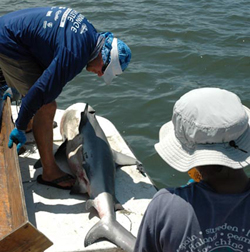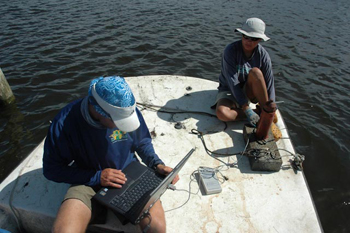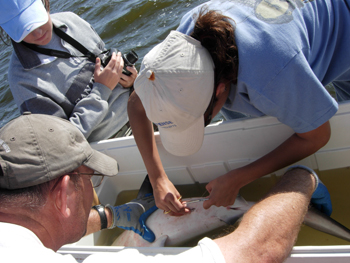
Photo by Bill Kanapaux
Indian River Lagoon, on Florida’s east coast, has historically served as habitat for an abundance of marine life. But human pressures have changed all that, and Florida Museum researchers now are working to understand the population dynamics of species that still inhabit the lagoon while searching for signs that other species, such as the smalltooth sawfish, might be returning.
Bull sharks, a species of concern in Florida, use the lagoon as a nursery and may stay there until they are about nine years old. Over the summer, Florida Museum’s research biologist Jason Romine and field biologist Johanna Imhoff used acoustic tags and a network of listening devices within the lagoon to study these sharks and learn more about their habits and movements.
The study area comprises about 60 miles of the lagoon, from the Banana River, which is just south of the Kennedy Space Center, down to Sebastian.
In total, the lagoon covers 156 miles of coastline, averages four feet deep and has only five inlets into the ocean, making for a biologically diverse estuary. Highway 1 borders the lagoon to the west. To the east a thin sliver of land, most of it heavily developed, sits between the lagoon and the Atlantic.
Once a month, Florida Museum researchers spend several days running long lines to catch juvenile bull sharks in the lagoon. Each long line contains about 50 hooks spaced at 30 foot intervals. Each hook is attached to a five-foot piece of monofilament with a 1200-pound test.
A buoy marks each end of the long line. In some cases, Romine said, buoys are placed every 20 feet or so. That way, if a shark bites off the line, the researcher can get to the nearest buoy and retrieve the rest of the line.
The two researchers apply special telemetry tags that send signals to 40 receivers placed throughout the lagoon. Whenever a tagged shark swims within 150 meters of a receiver, the device records the tag number, time and date. In this way Florida Museum researchers hope to gain a better understanding of how bull sharks use the lagoon.
Many of the receivers are located near power stations and creeks to determine how human-based changes, including the destruction of mangrove habitat, might affect the lagoon’s inhabitants.
Through October, the museum’s Florida Program for Shark Research hoped to have 19 acoustic tags on juvenile bull sharks. The tags, which cost about $330 each, are expected to last about three years.
On the water
On an August afternoon, Romine and Imhoff launched from a boat ramp at Barefoot Bay, near the southern edge of their research boundary. The two researchers had strung a long line baited with jack in the lagoon’s murky waters in a spot about seven feet deep. They let it sit for two hours before returning to see what they had caught.

Photo by Bill Kanapaux
The first hook held a four-foot bull shark, an immature female. Romine pulled the shark to the side of the boat and tied down the long line to the bow as Imhoff worked to lasso the tail and secure the shark’s back end. Romine then rolled the shark onto its back, exposing the belly and making the shark docile.
Using a scalpel, Romine cut into the shark’s body cavity deeply enough to implant the acoustic tag, which is about the size of a AA battery but half as long. Imhoff then stitched up the incision, inserted a visual tag into the base of the dorsal fin and measured the shark’s length.
Their work completed, Romine removed the hook with bolt cutters, and Imhoff released the tail. Romine then turned the shark onto its back and held its fin until it recovered from the shock. As the shark regained its strength, Romine let go and watched as it swam away and disappeared beneath the surface.
The next hook brought up a catfish. Imhoff had been badly spiked by one just a month earlier. The spine had gone into the finger, down to the bone. In this line of research, you have to work quickly and carefully, and sharks aren’t the only potential danger.
The line brought up two more juvenile bull sharks in quick succession, one male and one female. As Romine pulled up the third shark, Imhoff saw another one skim past the boat. “Not a good place to go for a swim,” she said.
Only two acoustic tags remained. Romine decided to save them for any smaller sharks they might find at the next survey spot, 10 miles north near Melbourne.

Photo By Bill Kanapaux
The line brought up two more sharks: a feisty female that was 5.5 feet long and the largest catch of the day, a six-foot immature female that didn’t survive its time on the line. Of all the long line catches, this was only the second fatality, Romine said.
Romine checked the dead shark’s stomach contents (it was empty) and then carved out a portion of the spinal column and the intact jaws. The vertebrae would be used to determine the shark’s age for an ongoing assessment of the lagoon’s shark population. The vertebrae and jaws would be sent to a researcher at the Florida Fish and Wildlife Conservation Commission.
Recording juvenile behavior
Researchers expect juvenile sharks to leave the lagoon as the water turns cooler but they can’t be sure, Romine said. The previous year, some of the juveniles stayed in the waters near NASA all winter despite the risk of potentially fatal cold snaps. Those that do leave usually start coming back in April, he said, but it could be earlier depending on the water temperature.
The acoustic tags will give researchers a better picture of those patterns.
Each listening device is marked by two small buoys, one on the surface to mark the location and another underwater to show where the line is. For one receiver near Barefoot Bay, Imhoff used a hook to grab the line and pull up the device: a metal canister about a foot high attached to a small cinder block. The cinder block itself was attached to a sand anchor on the lagoon’s bottom to keep it in place.
Romine plugged a serial port cable into the receiver and uploaded its data into a laptop computer. He then could see whether any tagged sharks had passed the receiver and when during the weeks since he last checked the device.

Photo By Jason Romine
After recording the data, Romine dropped off Imhoff at the boat ramp to drive the truck up to a ramp in Melbourne and meet him there. At this new location, Romine and Imhoff busied themselves baiting hooks for a second long line drop, hoping to catch two more bull sharks to take the remaining acoustic tags.
Romine slowly backed up the boat, the bow facing perpendicular to the waves. After dropping an anchor and buoy, Imhoff attached a baited hook and its five feet of mono-filament to the steel cable of the long line. At each 30-foot interval, she attached another hook until the line stretched across hundreds of feet.
While waiting to pull up the line, Romine and Imhoff busied themselves checking two more receivers. Both of them caused their share of headaches. One sat in a creek near a bridge for Highway 1, perched next to a deep hole that caused plenty of trouble trying to place it back at the bottom where it could be retrieved.
Back in the bay, wave action made the second receiver difficult to retrieve. A taut line kept yanking the barnacle-encrusted device overboard, resulting in bloodied hands for both Romine and Imhoff.
As Romine watched the data upload to his laptop, he discovered that four sharks previously tagged south near Barefoot Bay had passed by the receiver. Two of the sharks had been there earlier that very day. The other two sharks had made the 10-mile trip to Melbourne about three days after being tagged. Romine hadn’t expected the sharks to make it that far north. “Cool,” he said. “That kind of made my day.”
The two started pulling up the long line at about 5 p.m. Only catfish took the bait, no sharks in sight. The two extra acoustic tags would have to wait.
- Learn more about the Florida Program for Shark Research at the Florida Museum.
- Learn more about the Ichthyology Collection at the Florida Museum.